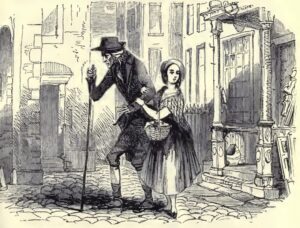We are reading Dickens’ first drafts.
That is the thought that struck me after reading The Old Curiosity Shop. This novel begins with a peculiarity: an unnamed observer who narrates the story while making no contribution to it and, after three short chapters, completely disappears. He has the decency to say good-bye: “I shall for the convenience of the narrative detach myself from its further course, and leave those who have prominent and necessary parts in it to speak and act for themselves.” That is, perhaps, sufficient explanation for his going, but not for his appearing in the first place.

Another character disappears more subtly, and yet rather more notably—Fred Trent, the older brother and moral opposite of Little Nell. Introduced by the vanishing narrator, Trent persisted in the story for perhaps 150 pages longer. He intended, evidently, to be a principal villain. He plotted to get his grandfather’s money, plotted to marry off his sister to his stooge of a friend, plotted to hunt down both relatives when they fled the city. He is attributed with some past entanglement with the young wife of the jealous, malignant Quilp. And it all comes to nothing, and Trent slips off the pages. Dickens remembers him only at the close of the novel, and only to give him a bad, thoroughly unconnected end.
Beyond the characters who disappear are the characters who transform. Dick Swiveller begins the story as nothing more than a fool; he ends as little less than a hero. Kit Nubbles walks into the narrative with “the most comical expression of face;” he “would have amused one anywhere,” and his weekly writing lesson is little more than an occasion to “wallow in blots, and to daub himself with ink up to the very roots of his hair.” From this comical dolt, Kit becomes a well-spoken, upstanding young man who secures a bright future.
Like these two characters, The Old Curiosity Shop developed from inauspicious beginnings to something quite creditable. The first chapter of the story was originally the fourth entry of another series. Titled Master Humphrey’s Clock, the series was a collection of miscellaneous stories and sketches, published in a weekly paper. But Dickens discovered that a miscellany was far less popular, and thus far less profitable, than a novel. He aborted Master Humphrey’s Clock early in its course, and that collection “became one of the lost books of the earth” (as Dickens wrote, with regret that seeps through the ink, in his preface to the 1848 edition of The Old Curiosity Shop). Leaving behind Master Humphrey, Dickens devoted himself to the story of Little Nell, and The Old Curiosity Shop transformed from one item in a collection to a bona fide novel. As Dickens noted—again, in the 1848 preface—the novel “was written and published from week to week, in weekly parts.”
I had known before that Dickens wrote and published weekly; I had even noticed its effects (Pickwick is likewise ennobled over the course of his serial). But The Old Curiosity Shop brought home to me the reality of what Dickens did. The unevenness of the novel is the unevenness of a first draft, when ideas and characters are still nebulous, and would have been smoothed out in a final draft. But there was no final draft. Dickens published as he wrote, and never had the opportunity to revise the parts in view of the whole.
So we read Dickens’ first drafts, and when you realize that, they are all that more impressive.




Leave a Reply